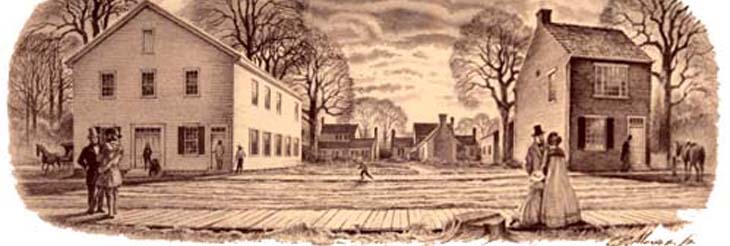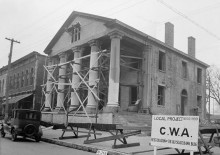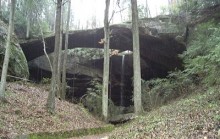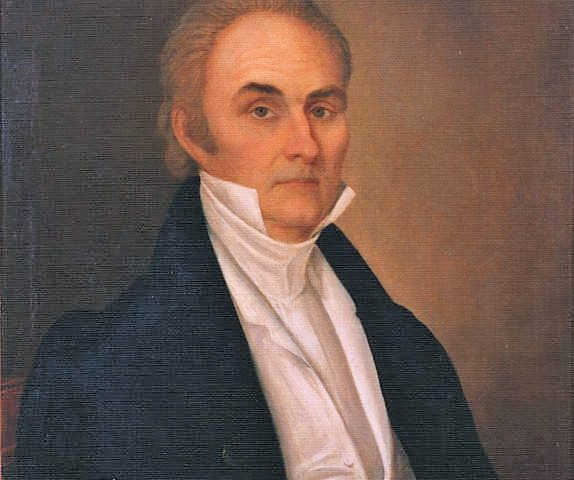ALABAMA BECOMES A TERRITORY
After the war of 1812, and with the defeat of the Creek Indians, land in Alabama became open to new settlers seeking an opportunity in the Mississippi Territory. They came from many states. Some of the first settlers of Alabama came from Virginia, Georgia, Tennessee, South Carolina and North Carolina. Wagon trains from individual states formed and they tended to congregate and settle in various parts of Alabama. “The land had to be surveyed before it could be sold, but the immigrants were impatient. They rushed in during this period of “Alabama fever” laid claim to tracts, and became squatters..
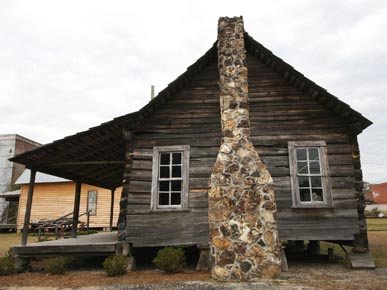
Georgians settled in eastern part
The Georgians settled in the eastern part of the State while further west and southerly were the North Carolinians and Virginians. Some North Carolinians and Virginians also settled in North Alabama, especially Huntsville. Tennesseans settled in the North and further south in the counties of Bibb and Shelby. Some of the settlers of what was to be Cahaba, later Bibb County were first attracted to this “valley of very inviting land” when they were fighting the Indians with ANDREW JACKSON in 1814. ii
In the regions around Montgomery, Georgians predominated for a long time while Virginians and Carolinians were in the counties of Perry, Greene, Tuskaloosa, Marengo, Dallas, Monroe and Wilcox.
President Monroe and Andrew Jackson owned land in Alabama
In west Alabama, around Florence, land buyers included PRESIDENT JAMES MONROE, JOHN COFFEE and ANDREW JACKSON. New towns began to spring up everywhere as the population increased. Clayton, Russellville, Claiborne, Athens, Demopolis, Eaglesville, Cahawba, Selma, Northport and Montgomery were some of the new towns.

“After the downfall of Napoleon in 1815, many of his officers and adherents came to the United States as refugees from the vindictive persecutions of the restored Bourbon dynasty. Among them were several Marshals and Generals of Napoleon and other prominent citizens with their families. Congress made a donation of lands in the vicinity of Demopolis to the French emigrants, with the view of introducing the culture of the grape and the olive.” Descendants of these immigrants reside in Marengo (named by the French) and the adjoining counties.”iii
Squatters were removed
PRESIDENT JAMES MONROE ordered the removal of the squatter in a proclamation December 1815, even sending soldiers to burn their cabins. Congress responded to the resulting protests of the immigrants into the Creek cession by the act of April 16, 1816, that permitted those who had immigrated before February of that year to remain until the land on which they settled was offered for sale. Many people had exhausted all their means in their effort to reach Alabama and even if they wanted to, they were incapable of returning to their former homes. Quite a few early settlers remained squatters for years due to the proclamation.iv
By an act of congress, dated March 1, 1817, the Mississippi Territory was divided. Another act, bearing the date March 3, organized the western part into a territory to be known as Alabama v The act declared the seat of government of the Territory should be St. Stephens, a former Spanish fort, in Northern Alabama until otherwise provided and that the president should appoint a governor with the authority to convene members of the legislative council and house of representatives of the new Mississippi Territory, “Alabama” from the areas that fell by division within the limits of the new Territory. The new Alabama Territory included the counties of present day Mobile, Baldwin, Washington, Madison, Clarke, Limestone and Lauderdale.
Huntsville responds
Huntsville town commissioners and property owners placed lots up for sale on July 5, 1815. An act on December 12, 1816, authorized the County to complete the Courthouse and to buy a jail lot. A new office, created by an 1812 act, was in operation, with WILLIAM PARHAM holding the title of County Ranger, in 1814.
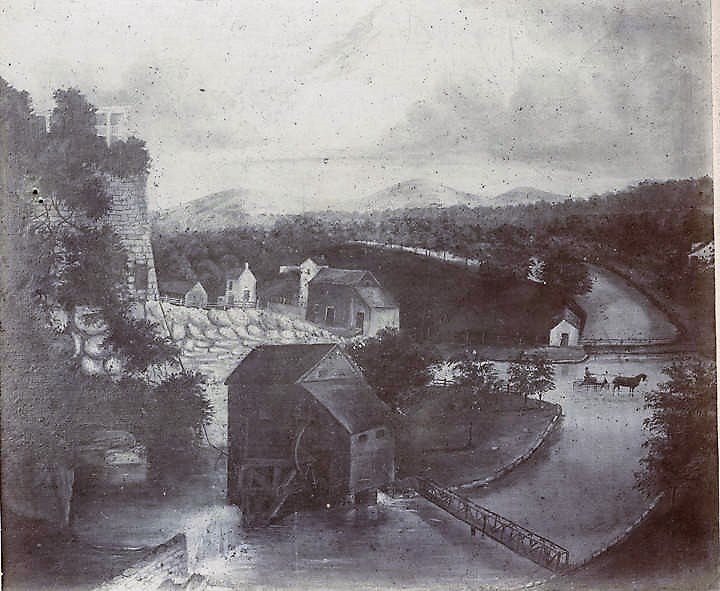
A presidential proclamation of May 26, 1816 provided for sale at Huntsville of lots for the town of Marathon, near Muscle Shoals.
“JOHN COFFEE, surveyor-general for the northern half of the Alabama Territory, appointed BENJAMIN and HARDY CLEMENTS to lay the section lines in the western Alabama region that included Cahaba and Tuscaloosa Counties. They are said to have arrived from South Carolina with only their horses, saddles, surveying instruments, and the clothes on their backs. Their work in Tuscaloosa County was interrupted by an Indian attack, but their survey of Cahaba County was apparently without incident, though their field notes of December 1818, made three miles above the present Sandy community near Centreville, record that a recent hurricane had torn down trees for a distance of half a mile.
Problems organizing the State
When Alabama was admitted into the Union in 1819, the state populace originated from so many different states that it created somewhat of a problem when the first General Assembly met to organize the Government of the newly recognized Alabama Territory. Character traits peculiar to their former state were observed in the men chosen to represent them at the General Assembly. For example, the Georgians were opposed to the judicial system of Alabama generally, preferring the Georgia plan of a “special jury,” instead of the tribunals where no jury trials existed. “It was difficult for them to get in the habit of writing “Beats,” to distinguish the civil divisions of a county, in place of “Districts,” as they were called in Georgia.
Not many Virginians, sought places in the Legislature. They came to Alabama as wealthy, independent planters. However, Virgina Legislators had little use for any other law book beyond the “Revised Statutes of 1819” and the laws therin, and looked to improve the laws of Alabama by engrafting provisions of the Virginia Code which had existed for a hundred years.
An amusing anecdote will illustrate this point. “In one of the southern counties lived COL. GIBBS, a high-toned spirited Virginian. He was drawn and summoned on the Grand Jury, and his prominence caused him to be appointed foreman. After the Judge had charged the jury, and before they retired, COL. GIBBS addressed the Court with much gravity, and inquired whether they were to be governed by the “Virginia Revised Code of 1819;” and being informed that they were not, he seemed greatly puzzled as to how the jury would get along.
The South Carolinians were less wedded to their State Legislature. They were enlightened and well informed upon the general upon the general scope of legislation, but they did not favor a penitentiary system, or the law of divorce-things unknown in the statutes of South Carolina.
Tennesseans were generally known by their reference to “Haywood’s Digest,” or that of a later date by Caruthers & Nicholson. They also were in favor of the Tennessee law for the redemption of real estate, changing the mode of assessing the taxes to conform with Tennessee’s laws and practice making them the duty of a Justice of the Peace in each beat. The Tennesseans were also attentive to the road laws regarding
Governor Appointed by President Monroe
WILLIAM WYATT BIBB, of Georgia was appointed Governor of Alabama by PRESIDENT JAMES MONROE. “MARMADUKE WILLIAMS, of Madison County, whose appointment was urged by his brother, former Territorial Governor WILLIAMS, was unsuccessful in obtaining the appointment.”viii
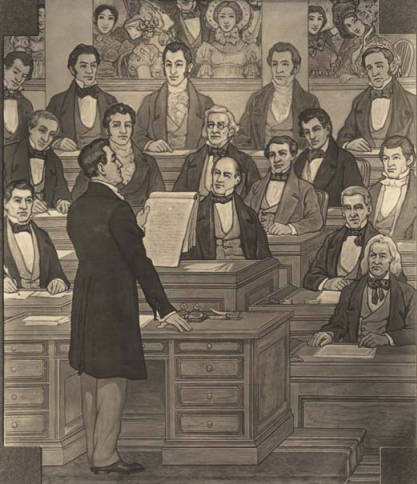
JOHN W. WALKER of Madison County was nominated by the President as United States Attorney for the territory. However, he never accepted the post and it was withdrawn on December 15, 1817, but he was still commissioned Territory Secretary on December 16. The only problem was that WALKER was never officially informed of the
The first territorial legislature met January 19,
He met alone
The legislature council consisted of one member, MR TITUS of Madison, who was the President. Mr. TITUS was the only member of the legislative council whose residence fell within the limit of Alabama. This created a problem because during the entire session of the first legislature of the territory, he occupied a separate chamber and adopted or rejected the various measures from the other house with all the parliamentary formality.xi “He sat, all alone, called the council to order, answered the roll call composed of only himself, elected himself President of the Council, voted on bills, appointed a Secretary and Doorkeeper and finally graveled the Council to an adjournment.”xii
The house consisted of ten representatives with GABRIEL MOORE of Madison as the President and the first speaker of the house. He was chosen by the same 12 members of the Alabama delegation of the Mississippi Territorial legislature and they remained in their positions until an election would take place. MOORE had served as Speaker of the Mississippi Territory previously and when he left, his place was taken by SAMUEL WALKER.
Alabama was divided into three Council Districts
In his first address to the assembly, BIBB recommended the advancement of education, the establishment of roads, bridges and ferries, the alteration in the boundaries of counties, and the formation of new ones, and many other things, calculated to promote the welfare of the Territory.xiii
“When the first session adjourned Feb. 4, 1818, Alabama was divided into three Council Districts, with LEMUEL MEAD, DR. HENRY CHAMBERS and JAMES TITUS of Madison County being appointed as Council Members or better known today as Senators.
THOMAS EASTON was elected Territorial printer. GEORGE PHILLIPS, JOSEPH HOWARD, MATHEW WILSON, JOSEPH P. KENNEDY, JOHN GAYLE and REUBEN SAFFOLD were selected as nominees, from whose number the President of the United States should select three members for the next legislative council.
New Counties Established
“The counties of Cotaco, Lawrence, Franklin, Limestone, Lauderdale, Blount, Tuscaloosa, Marengo, Shelby, Cahawba, Dallas, Marion and Conecuh were established. In each, the superior courts of law and equity, and two county courts, and one intermediate court, were to be holden annually. They were allowed one representative each in the legislature.
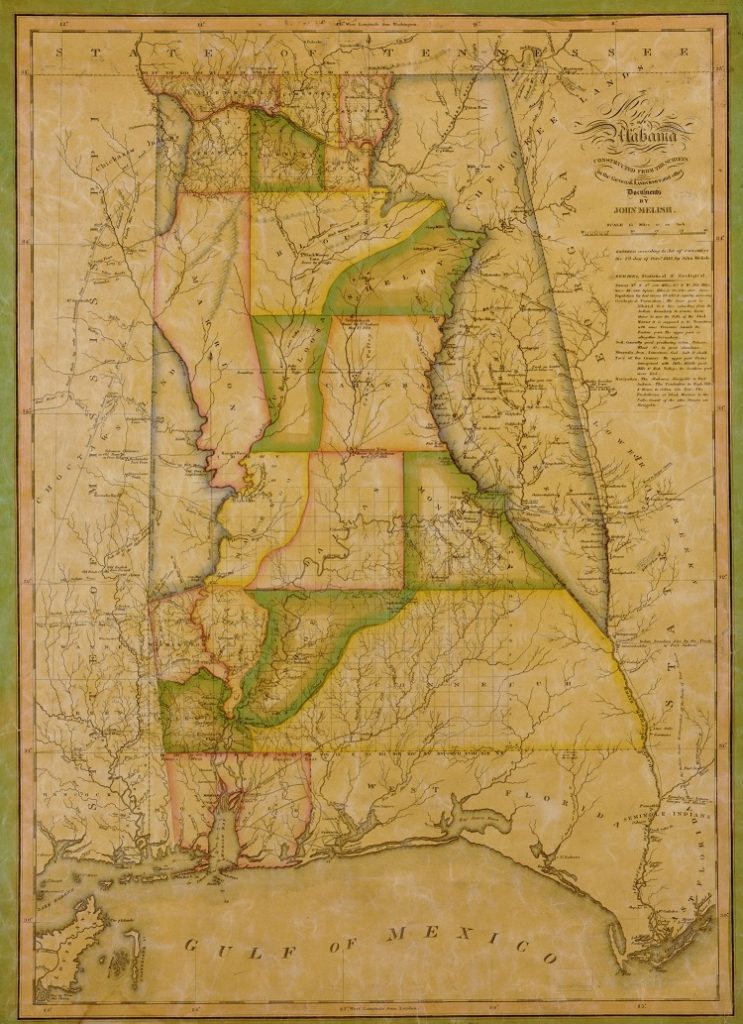
1823 Map of Alabama
The boundaries of Washington, Baldwin, Mobile and Marengo were altered and extended. Madison, the shape of which was formerly that of a triangle, was now made to assume its present form. The St. Stephens Academy was incorporated, and its trustees authorized to raise four thousand dollars by a lottery. “The St. Stephens Steamboat Company” was also incorporated. HUDSON POWELL, ROBERT GASTON, JOSEPH H. HOWARD, HOWELL ROSE and GEORGE DABNEY were appointed commissioners to select a temporary place at which to hold the courts of Montgomery county, then of vast extent.
The legislature repealed the laws upon usury, and allowed any interest agreed upon between the parties, and expressed in writing, to be legal. The compensation of the members was fixed by themselves. The speaker and president were allowed seven and the members five dollars per diem, besides
CLEMENT C. CLAY, SAMUEL TAYLOR, SAMUEL DALE, JAMES TITUS and WILLIAM L. ADAMS were elected commissioners to report to the next session the most central and eligible site for the Territorial legislature.
Madison, Limestone, Lauderdale, Franklin, Lawrence and Catoco counties were erected into the “northern judicial district.” GOVERNOR BIBB, on the 14th February, appointed HENRY MINOR attorney-general of this district.
Clarke, Washington; Monroe, Conecuh, Baldwin and Mobile counties composed the “the southern judicial district,” and MATHEW D. WILSON was appointed the attorney-general thereof.
Marion, Blount, Shelby, Montgomery, Cahawba, Marengo, Dallas and Tuscaloosa counties, composed the ‘middle judicial district,” and JOSEPH NOBLE was appointed its attorney-general.”
Before the division of the Mississippi Territory, and while the legislature sat at Washington, in Adams county, a stock bank had been established at Huntsville. A resolution adopted at the session of St. Stephens changed its name to that of “Planters’ and Merchants’ Bank of Huntsville.” The Tombigby stock bank was also now established, with a capital of five hundred thousand dollars.”xiv
i Ellison, Rhoda Coleman, Bibb County, The First Hundred Years, p.12
ii Ellison, Rhoda Coleman, Bibb County, The First Hundred Years, p. 13
iii Reminiscences of Public Men in Alabama for Thirty Years: p. 37
iv Ellison, Rhoda Coleman, Bibb County, The First Hundred Years, p.12
v Brewer, W. Alabama Her History, Resources, War Record & Public Men, 1872, Barrett & Brown Steam Printers & Book Binders
vi Ellison, Rhoda Coleman, Bibb County, The First Hundred Years, p. 12
vii Reminiscences of Public Men in Alabama for Thirty Years: p. 34, 35
viii Record, James, A DREAM COME TRUE, 1970, John Hicklin Printing Co. p.53,54
ix Record, James, A DREAM COME TRUE, 1970, John Hicklin Printing Co. p.53,54
x Record, James, A DREAM COME TRUE, 1970, John Hicklin Printing Co. p. 53, 54
xi Brewer, W, Alabama Her History, Resources, War Record & Public Men, 1872, Barrett & Brown Steam Printers & Book Binders
xii Record, James, A DREAM COME TRUE, 1970, John Hicklin Printing Co. p. 53,54
xiii Pickett, Albert H. HISTORY OF OF ALABAMA, 1896
xiv Pickett, Albert H. HISTORY OF OF ALABAMA, 1896
Read more details about the beginning of Alabama in our Alabama Footprints Series
ALABAMA FOOTPRINTS – Volume I – IV: Four Volumes in One
The first four Alabama Footprints books – Volumes 1-IV have been combined into one book
ALABAMA FOOTPRINTS Exploration
ALABAMA FOOTPRINTS Settlement
ALABAMA FOOTPRINTS Pioneers
ALABAMA FOOTPRINTS Statehood


